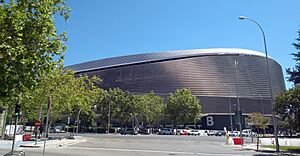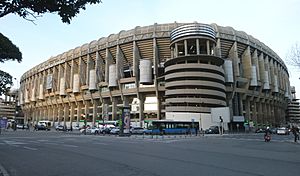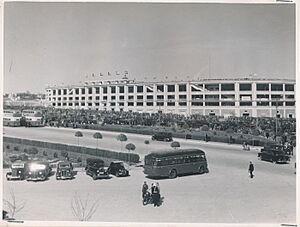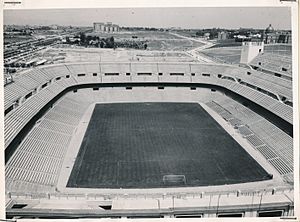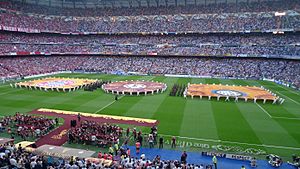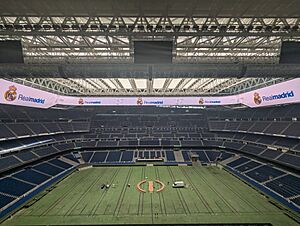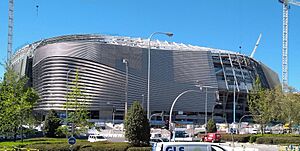Santiago Bernabéu Stadium facts for kids
|
El Bernabéu
Nuevo Chamartín |
|
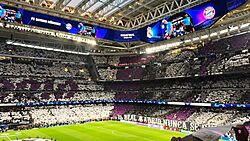
|
|
| Full name | Estadio Santiago Bernabéu |
|---|---|
| Former names | Estadio Real Madrid Club de Fútbol (1947–1955) |
| Location | Chamartín, Madrid, Spain |
| Public transit | |
| Executive suites | 245 |
| Capacity | 80000
List
100,000 (1947–1952)
125,000 (1952–1978) 90,000 (1978–1994) 110,000 (1994–1999) 81,044 (1999–2020) |
| Record attendance | 129,690 (Real Madrid v. AC Milan, 19 April 1956) |
| Field size | 105 m × 68 m (344 ft × 223 ft) |
| Surface | Mixto hybrid grass |
| Construction | |
| Built | October 1944 – December 1947 |
| Opened | 14 December 1947 |
| Renovated | 1982, 2001, 2019–2024 |
| Expanded | 1952, 1992, 1994, 2011 |
| Reopened | 23 December 2023 |
| Construction cost | 288,342,653 Ptas (€1,732,943) Renovations: 1982: $4.7 million 2000: €127 million 2024: €1.76 billion |
| Architect | Manuel Muñoz Monasterio Luis Alemany Soler Antonio Lamela (expansion) |
| Tenants | |
| Real Madrid (1947–present) Spain (selected matches) |
|
The Santiago Bernabéu Stadium is a famous football stadium in Madrid, Spain. It is the home stadium for the legendary club Real Madrid. The stadium has a seating capacity of about 83,186 people. This makes it the second-largest football stadium in Spain.
The stadium is named after Santiago Bernabéu, a former player and president of Real Madrid. It is known worldwide as a top football venue. Many important matches have been played here. These include four European Cup/UEFA Champions League finals. It also hosted the final of the 1964 European Nations' Cup and the 1982 FIFA World Cup. This makes it the first stadium in Europe to host both a UEFA Euro final and a FIFA World Cup final.
Contents
History of the Stadium
Building a New Home
In the early 1940s, Real Madrid's old stadium, Campo de Chamartín, was too small. Football was becoming very popular in Madrid. The club needed a much bigger stadium.
Santiago Bernabéu became president in 1943. He had a big dream: to build a huge stadium for 75,000 fans. He believed a larger stadium would help the club grow. It would bring in more money, attract better players, and get more supporters.
The club bought land next to the old stadium in 1944. They held a competition to pick the best design. Architects Manuel Muñoz Monasterio and Luis Alemany Soler won. Construction started on October 27, 1944.
Building the stadium was hard. There was a shortage of materials after the war. Banks were not sure about investing in football. But Santiago Bernabéu found a way to get money. He sold special bonds to fans and got a loan from a supportive bank.
The construction company Huarte y Compañía, S.A. built the stadium. It took over 30 months. Real Madrid had to play some games at another stadium during this time.
Opening Day
The stadium opened on December 14, 1947. Real Madrid played a friendly match against a Portuguese team, Os Belenenses. Real Madrid's player, Sabino Barinaga, scored the first goal.
The first official game was on December 28, 1947. Real Madrid won 5–1 against Atlético de Bilbao. The stadium was first called "Estadio Real Madrid Club de Fútbol." But fans often called it "New Chamartín Stadium." It could hold 75,145 spectators, with many standing areas.
Changes Over the Years
The stadium got its first big upgrade in 1955. Its capacity grew to 125,000 fans. This made it the biggest stadium in the new European Cup.
On January 4, 1955, the stadium was officially renamed the Santiago Bernabéu Stadium. This honored the club's president. In 1957, bright floodlights were added for night games.
In 1965, all of Real Madrid's offices moved into the stadium. In 1972, the first electronic scoreboard was installed.
Hosting the World Cup
Big changes happened in the early 1980s. Spain was hosting the 1982 FIFA World Cup. The stadium needed to be updated. Architects Rafael Luis Alemany and Manuel Salinas led the renovation. They were the sons of one of the original architects.
A new roof was added to cover most of the seats. The stadium's capacity was reduced to 90,000 seats. New electronic signs and improved areas for the press and players were also added.
The stadium hosted four World Cup matches. This included the exciting final between Italy and West Germany.
Safety and Modernization in the 1990s
After some sad events at other stadiums, new rules came out for fan safety. The Santiago Bernabéu had to make changes. It added separate paths to different sections and seats for everyone.
From 1992 to 1994, the stadium was expanded again. New seating areas were built, and the stadium became much taller. This caused parts of the field to be in the shade, harming the grass. So, a special heating system was put under the pitch to keep the grass healthy.
A retractable protective roof was also installed. This kept fans safe from bad weather. After these changes, the stadium could hold 106,000 spectators.
In 1997, UEFA required all stadiums to have only seats. This reduced the Bernabéu's capacity to 74,328. In 1999, the "Tour Bernabéu" and club museum opened.
New Millennium, New Look
When Florentino Pérez became president, he started a "Master Plan." The goal was to make the stadium more comfortable and earn more money.
From 2001 to 2006, €127 million was spent on upgrades. These included new VIP areas, new dressing rooms, and better sound systems. Heating was added to the stands. New restaurants and escalators were also installed. After these updates, the stadium's capacity grew to 80,354 seats.
In 2007, UEFA called the Santiago Bernabéu an "Elite Stadium." It was chosen to host the 2010 UEFA Champions League final.
In 2011, more seats were added, bringing the capacity to 81,044. In 2018, the stadium hosted the 2018 Copa Libertadores finals second leg. This made it the first stadium to host the finals of four of the world's biggest football tournaments.
Amazing Renovation (2019–2024)
Real Madrid started a huge renovation project from 2019 to 2024. The goal was to make the Santiago Bernabéu a global symbol of sports architecture. It also aimed to make it a major source of income for the club.
The plan included a new outer shell and a roof that covers all seats. It also added eco-friendly systems. The project was approved by the Madrid City Council in 2017. Construction began in June 2019.
The renovation was completed in late 2024. The stadium now has a retractable roof and a retractable pitch. This means the grass can be moved away when other events are held. This makes the stadium useful for many different activities.
Stadium Location
The stadium is in the Chamartín area of Madrid. It is surrounded by the Paseo de la Castellana and the streets of Concha Espina, Padre Damián, and Rafael Salgado.
Getting There
The stadium has its own metro station called Santiago Bernabéu on Line 10. Many bus routes also serve the stadium.
Big Club Matches
UEFA Champions League Finals
The Santiago Bernabéu Stadium has hosted four UEFA Champions League finals.
| Date | Winner | Score | Runner Up | Attendance |
|---|---|---|---|---|
| 30 May 1957 | 2–0 | 124,000 | ||
| 28 May 1969 | 4–1 | 31,782 | ||
| 28 May 1980 | 1–0 | 51,000 | ||
| 22 May 2010 | 2–0 | 73,490 |
1957 European Cup Final Real Madrid played against Fiorentina from Italy. Real Madrid won 2–0, earning their second European Cup in a row.
1969 European Cup Final Milan from Italy beat Ajax from the Netherlands 4–1. Milan won their second European championship.
1980 European Cup Final Nottingham Forest from England won 1–0 against Hamburger SV from Germany. This was Nottingham Forest's second European Cup win.
2010 UEFA Champions League Final Inter Milan from Italy defeated Bayern Munich from Germany 2–0. Inter Milan completed a historic "treble" (winning three major trophies in one season).
2018 Copa Libertadores Final This final was between two big rivals from Argentina, Boca Juniors and River Plate. The first game was a 2–2 draw. The second game had to be moved to Madrid because of fan trouble. River Plate won 3–1 after extra time. This was the first time the trophy was lifted outside South America.
Big International Matches
Euro 1964
The Santiago Bernabéu hosted three matches during the 1964 European Nations' Cup. Spain played two of these games. They won their semi-final against Hungary. Then, Spain beat the defending champions USSR 2–1 in the final.
| Date | Team #1 | Result | Team #2 | Round | Attendance | Ref. |
|---|---|---|---|---|---|---|
| 1 November 1962 | Spain |
6–0 | Preliminary round first leg | 51,608 | ||
| 17 June 1964 | Spain |
2–1 | Semi-final | 34,713 | ||
| 21 June 1964 | Spain |
2–1 | Final | 79,115 |
1982 FIFA World Cup
The stadium hosted four matches during the 1982 FIFA World Cup. Three were in the second round. The final match was also played here. Italy defeated West Germany 3–1 to win the World Cup.
| Date | Team #1 | Result | Team #2 | Round | Attendance | Ref. |
|---|---|---|---|---|---|---|
| 29 June 1982 | West Germany |
0–0 | Second group stage | 75,000 | ||
| 2 July 1982 | West Germany |
2–1 | Second group stage | 90,089 | ||
| 5 July 1982 | Spain |
0–0 | Second group stage | 75,000 | ||
| 11 July 1982 | Italy |
3–1 | Final | 90,000 |
Other Events at the Stadium
American Football
The Santiago Bernabéu hosted its first American football game on November 16, 1958. It was between two US Air Force teams. The stadium hosted its first National Football League game on November 16, 2025. The Miami Dolphins played the Washington Commanders.
| Year | Date | Designated
visitor |
Score | Designated
home team |
Score | Stadium | City | Attendance |
|---|---|---|---|---|---|---|---|---|
| 2025 | November 16 | Washington Commanders | Miami Dolphins | Santiago Bernabéu Stadium | Madrid |
Basketball
The Santiago Bernabéu Stadium hosted the opening match for EuroBasket 2029.
Cultural and Social Gatherings
The stadium has also been a place for important public events.
- In 1982, Pope John Paul II spoke to about 160,000 young people at the stadium.
Concerts and Music Events
Many famous musicians have performed at the Santiago Bernabéu Stadium.
- On September 12, 1983, Spanish singer Julio Iglesias performed for nearly 100,000 people. He gave another free concert in 1989.
- American singer Frank Sinatra performed his only concert in Madrid here on September 25, 1986.
- Irish rock band U2 held their first concert in Spain at the stadium on July 15, 1987.
- The cast of the Spanish singing show Operación Triunfo performed a sold-out concert on June 1, 2002. It was the most-watched concert in Spain.
- American rock musician Bruce Springsteen and the E Street Band performed at the stadium three times. They played in 2008, 2012, and 2016.
- The Rolling Stones played a sold-out show on June 25, 2014.
- The finalists of Operación Triunfo (ninth series) performed again on June 29, 2018.
- American pop singer Taylor Swift performed two shows on May 29 and 30, 2024. These were the first concerts at the newly renovated stadium.
- Colombian singer Karol G performed four shows in July 2024. She was the artist with the most performances at the stadium.
- Luis Miguel also performed in July 2024.
See also
 In Spanish: Estadio Santiago Bernabéu para niños
In Spanish: Estadio Santiago Bernabéu para niños
- Metropolitano Stadium, the home stadium of Real Madrid's inter-city rivals Atlético Madrid
- Lists of stadiums


